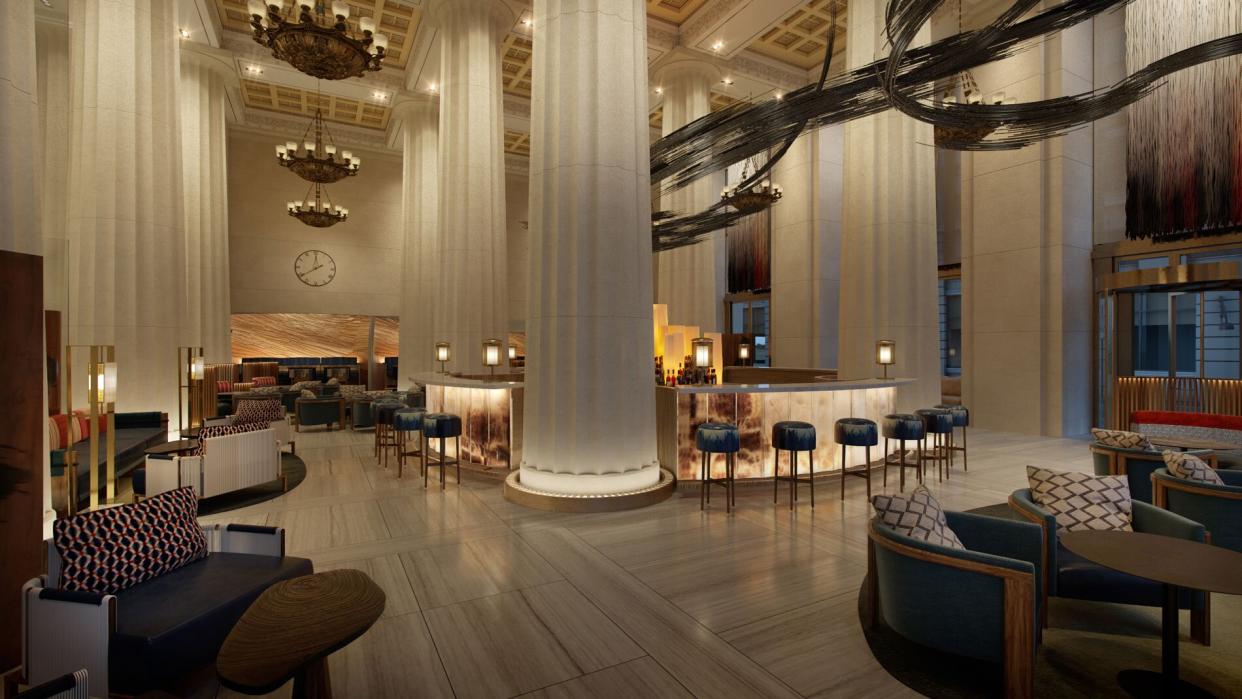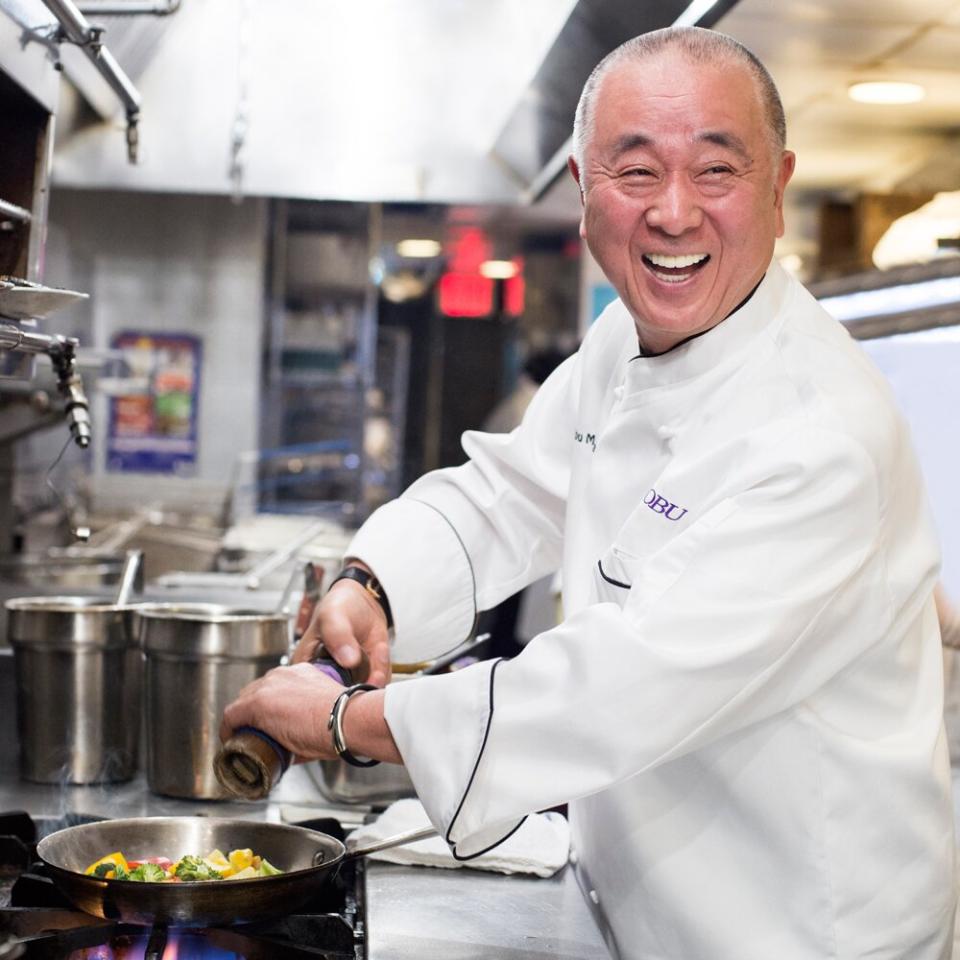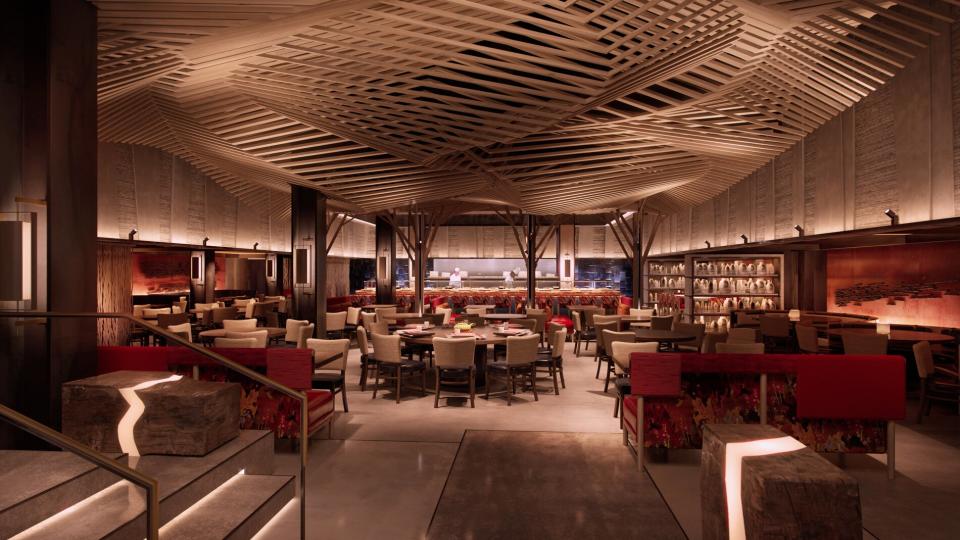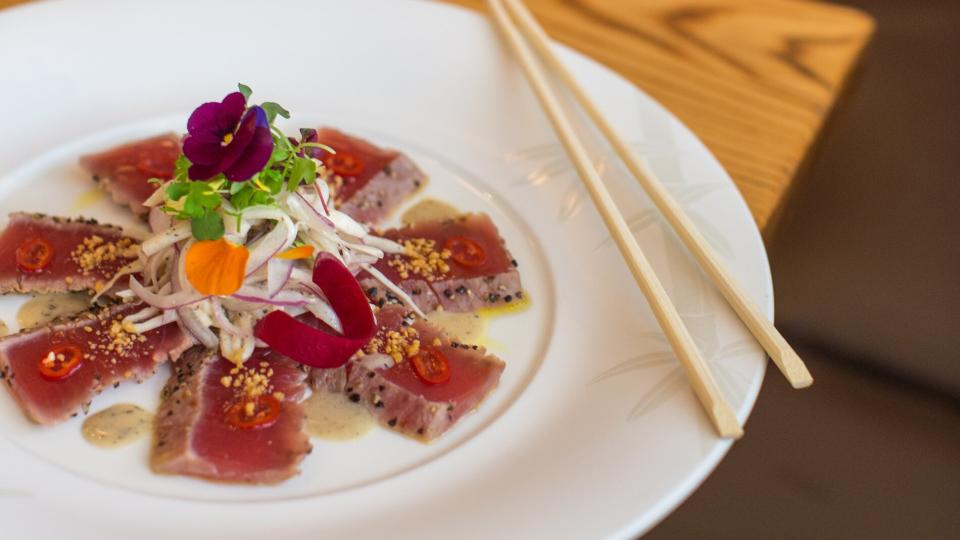Here's What's Next for Nobu

Courtesy of Rockwell Group
This Saturday, Nobu Tribeca will serve its last meal. It's a bittersweet moment for the owners of the 23-year-old institution that paved the way for a generation of Japanese restaurants in the U.S., but when this door closes, a massive new one is already set to open: A door to the new Nobu flagship at 195 Broadway.
There, in the landmarked former AT&T headquarters in the Financial District, is the two-floor, 12,000-square-foot future of Nobu. The David Rockwell-designed restaurant will have a massive bar and lounge on the ground floor, subterranean seating for 187 and a private sake table for the high rollers who have been flocking to the original restaurant since it opened in 1994.

? Evan Sung
Moving (further) downtown isn't the only big step the Nobu group is taking these days. In 2013, the first Nobu hotel opened in the Caesars Palace complex in Las Vegas, followed swiftly by similar projects in Manila and Miami. In the next 18 months, they plan to add six more hotels, in locations as far-ranging as London, Bahrain, and Cabo San Lucas, to that list. A New York hotel is on the horizon, too. It's a massive expansion for a brand that started life as a Japanese restaurant in an obscure Manhattan neighborhood, but for Nobu, somehow it's just not that shocking.
Nobu's origin story is the stuff of restaurant legend: While dining at chef Nobu Matsuhisa's eponymous L.A. restaurant, Matsuhisa, in the early '90s, Robert De Niro and his friend, producer Meir Teper, were so enamored of the food that they approached the chef to ask if he'd open a spot in New York City. When he agreed, De Niro, a tireless booster for his Tribeca neighborhood, brought on restaurateur Drew Nieporent, another local who was, at the time, running Tribeca Grill and Montrachet nearby. Throw in an audacious design by Rockwell, one of his first major restaurant commissions along with Matsuhisa's South American-inflected Japanese cuisine, and a mega-hit was born.

Courtesy of Rockwell Group
Twenty-three years and 32 locations later, it's inspired imitators by the dozen—Sushisamba, whose clubby atmosphere and Brazilian-Peruvian-Japanese cuisine were immortalized as a thing of the mid-oughts by an appearance on Sex and the City; London's aggressively named Sexy Fish, opened in 2015; "Every time you turn around you read about some 'Son of Nobu' restaurant with a chef that says he used to work at Nobu, but I don't remember the guy," says Nieporent. "A lot of these companies, when they have an opportunity, they try to pinch the staff. I've had to make a few phone calls over the years."
If the mark of culinary immortality is mainstream ubiquity, there are a small handful of chefs who have achieved it. The molten chocolate cake that Jean-Georges Vongerichten made famous at JoJo in 1987 can now be found in the frozen foods aisle at Wal-Mart and on the menu at Applebee's. Chez Panisse pizza chef Ed LaDou's BBQ chicken pizza is one of the "grownup" offerings on Chuck E. Cheese's menu. And Nobu's yellowtail-jalape?o, at the time a peculiar hallmark of his time spent serving sushi in Peru before he came to the U.S., is a common combination from Nobu-style imitators to grab-and-go grocery store sushi.
With that achievement under his belt, Matsuhisa has taken an unusual approach to his cuisine—consistency. Today, there are two basic paths for a chef looking to expand his empire: innovate, or go casual. The former is embodied by David Chang's Momofuku, which counts six different restaurants in New York, individual restaurants in Toronto, Washington, D.C., Las Vegas, and Sydney, plus the Milk Bar and Fuku chains as well as the Ando delivery service under its umbrella. The latter model is Shake Shack, the budget burger concept from Danny Meyer that has grown from a seasonal cart in Madison Square Park to 119 locations as far away as Dubai, South Korea, and Moscow.

? Henry Hargreaves
Even the high-profile chefs of Matsuhisa's generation have felt the need to diversify. Wolfgang Puck, who made his name in the early '90s with his version of California cuisine, is now opening steakhouses. Bobby Flay's Mesa Grill, where his Mediterranean-inflected Southwestern style was born in 1991, closed its flagship in 2013; the Flay brand is now thriving in 19 locations of an upscale burger restaurant called Bobby's Burger Palace. But Matsuhisa says, "Our customers know my philosophy. It makes us happy that the dishes we created when we first opened Nobu are still among the most popular dishes today."
Nobu did stand at those crossroads once, early on—in 1998, when, to answer the high demand for tables, they acquired the space next door and, for a moment, considered making it a late-night ramen shop tentatively called Nobu's Noodles. As the partners went back and forth on the details, Nieporent remembers, "It dawned on me, like, 'Here we are trying to conceptualize an annexed space to do a different concept when there's a demand for people who want the Nobu menu.'" They scrapped the ramen idea and opened Nobu Next Door, with most of the same menu.

Courtesy of Rockwell Group
So, where are they growing creatively? Hotels. As Teper puts it, "We saw that our restaurants in other brands' hotels were helping the hotels do better business, making the hotel more visible." It was De Niro who first suggested, eight years ago, that they could keep that business for themselves. It's the opposite of what many restaurateurs are doing these days; they see hotel groups as desirable partners because it means someone else shoulders the big costs of opening a new restaurant—real estate and buildout, often offering cut rates on rent and utilities—while also offering a built-in clientele. Instead, Nobu has chosen to wade directly into that morass of unknowns and operational costs in the name of control.
They're basically in uncharted territory. In London's Chinatown, Fergus Henderson and Trevor Gulliver opened the St. John Hotel in 2011, expanding Henderson's groundbreaking reclamation of British cuisine into a boutique, minimalist space with a restaurant anchor on the main floor, a bar/tea room for guests to enjoy Henderson's beloved elevenses, and a room tier cheekily named "Post Supper." Though it was awarded a Michelin star in 2013, the project went into administration a month later and was sold to a Singaporean hotel group, with Ferguson and Gulliver exiting the financially fraught business.
All of the Nobu partners are measured as they talk about the hotel expansion, as unassuming in their description of the project as its rapid growth is ambitious. "I don't think we invented anything new," says Teper. "There are many good hotels with good service around the world, but they don't have the food and beverage that we can provide." Matsuhisa concurs, while highlighting the hotels' prime locations: "To enjoy them, you need a simple, comfortable room with excellent service. And room service from Nobu is always good, too!"
It's much the same for the new Nobu Downtown: same experience, flashier digs. When it opens just a few weeks after Tribeca closes its doors for good, it'll bring over the entire Tribeca staff, including chef Ricky Estrellado, who has been with the restaurant since it opened. "The day that it becomes ritualistic, like a Benihana or something like that, we're in trouble," says Nieporent. Until then, Nobu's world will keep expanding.